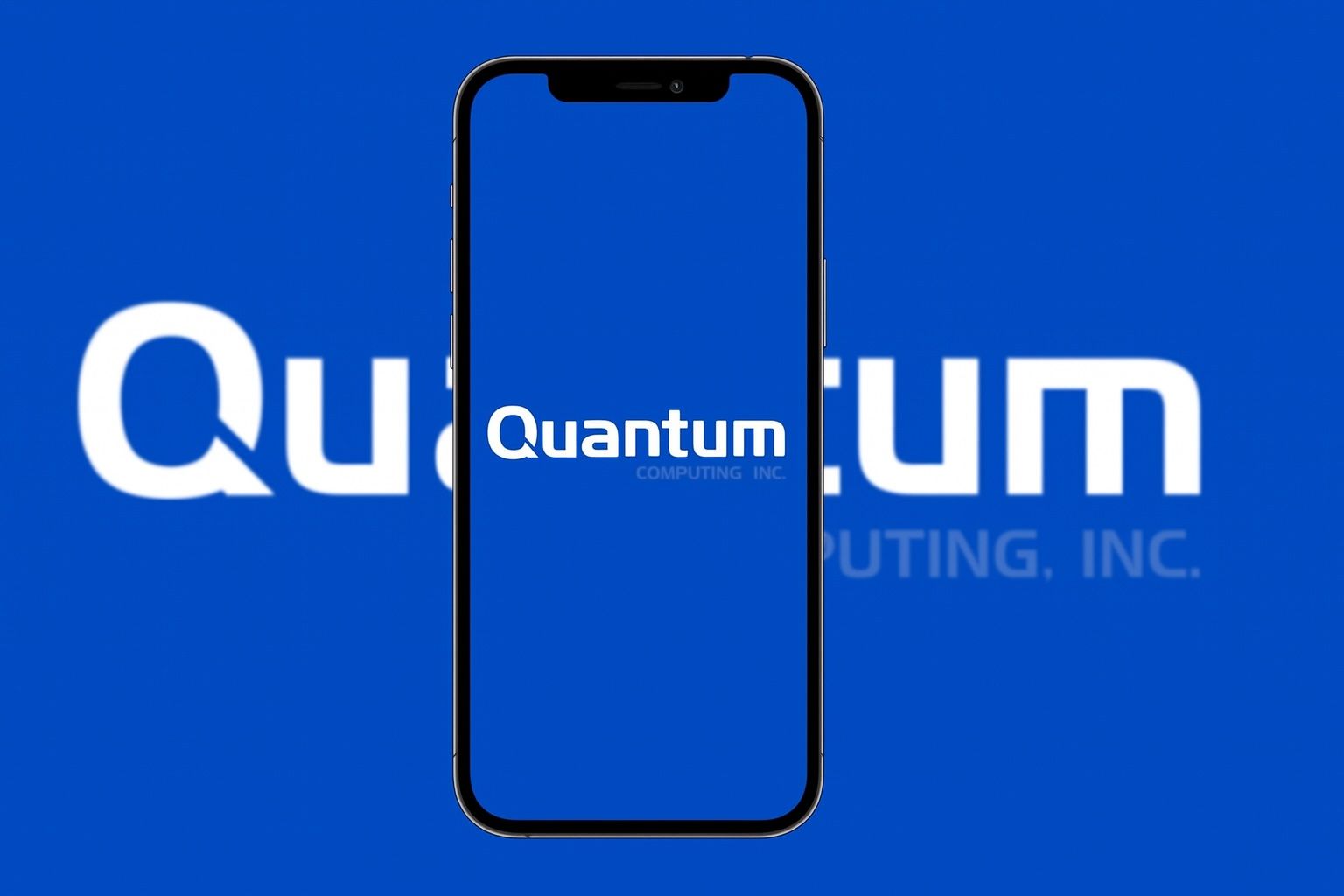- Stock Soars on Quantum Hype: Quantum Computing Inc. (NASDAQ: QUBT) has been one of 2025’s top-performing stocks, skyrocketing over 2,500% year-on-year. The share price spiked +23% in a single day on October 3, 2025 to close around $24.62 amid frenzied trading [1]. Over the past year QUBT exploded from penny-stock levels (52-week low ~$0.65) to highs above $25 [2], making it a poster child of the “quantum tech” stock rally.
- Massive $750 Million Cash Infusion: In late September, QUBT announced an oversubscribed $500 million private placement (later upsized to $750 million) of its stock at-market, bringing its total capital raised since late 2024 to roughly $1.6 billion [3]. “We now have the strongest balance sheet among publicly traded quantum companies,” said CEO Dr. Yuping Huang, noting the funding provides runway through 2028 [4]. The deal – led by institutional investors – vastly boosts QUBT’s cash war chest, though it also means significant shareholder dilution.
- New Quantum Tech Debut: QUBT is aggressively advancing photonic quantum technology. On Sept 29, it unveiled a “Quantum Secure Solution” – a room-temperature quantum encryption network using time-energy entangled photons (no cryogenics required) to safeguard data from future quantum hacking threats [5]. The platform, showcased at a major fiber-optics conference (ECOC 2025), is a “significant technological milestone” built for real-world deployment now, according to QUBT’s CEO [6]. Early trials are underway: QUBT opened its own photonic chip foundry in Arizona and notched pilot projects – including a NASA subcontract, a NIST quantum chip contract, and even a $332,000 sale to a top-5 bank for a quantum-secure cybersecurity testbed [7].
- Volatile Stock, Mixed Reactions: QUBT’s stock has seesawed on news of its cash raise and tech breakthroughs. It plunged ~11% on Oct 2 when the $750M financing and new product were revealed, then rebounded the next day amid a broader quantum-computing sector rally [8]. Trading volumes have been huge, and QUBT’s market cap now hovers around $4–5 billion. Notable investors are torn – some hail a coming “quantum gold rush” fueled by QUBT’s breakthroughs and liquidity, while others eye red flags. Insiders sold shares during the run-up (the CEO cashed out 1 million shares at ~$14.41 earlier in 2025) and a shareholder lawsuit alleges the company exaggerated its tech claims [9]. The stock’s valuation is extreme: QUBT posted only $61,000 in Q2 revenue (down 67% YoY) against a $36 million quarterly loss, putting its price-to-sales ratio above 10,000× [10].
- Wall Street Bulls vs. Bears: QUBT’s mind-bending rise has divided analysts and experts. Ascendiant Capital recently upgraded the stock with a $40 price target (from $22), implying substantial upside from current levels [11]. A Barron’s piece even trumpeted that QUBT shares “could rise 86%” further [12]. Earlier, Lake Street Capital initiated coverage at Buy with a $24 target, citing QUBT’s first-mover advantage in photonic quantum chips [13] [14]. At the same time, skeptics warn the fundamentals must catch up to the hype. “Only time will tell whether QCi lives up to expectations,” one Motley Fool analysis observed, “yet in the near term, hope and hype could continue” to propel the stock [15]. Overall, analyst opinions range from Hold to Buy, with price targets scattered from about $15 up to $40, reflecting both the enormous potential and the profound uncertainty surrounding QUBT’s future [16].
QUBT’s Spectacular Stock Surge in 2025
Quantum Computing Inc.’s share price has been on a meteoric rise throughout 2025, turning a little-known small-cap into one of the year’s most explosive tech stocks. Over the past 12 months, QUBT surged by over 2,500%, far outpacing even high-flying peers in the quantum computing space [17]. The stock climbed from mere cents to the mid-$20s, hitting an intraday high around $27 (its 52-week range spans $0.65 to $27.15) [18]. By early October 2025 its market capitalization swelled into the multi-billion range, a remarkable feat for a company with minimal revenues.
This rally reached a frenzy in the days around October 3, 2025. On that Friday, QUBT stock soared 23% in a single session to ~$24.62 [19] – the third straight day of gains after a brief pullback. It wasn’t an isolated jump: a sector-wide quantum computing rally was underway, lifting “Quantum Four” names like Rigetti, D-Wave, IonQ, and QUBT together [20]. Investors piled in amid a flurry of optimistic news. For instance, competitor Rigetti had just announced two purchase orders for its quantum systems totaling $5.7 million, sparking optimism that real commercial traction was finally arriving [21]. Likewise, D-Wave revealed a pilot project with UK police that improved emergency response times by 50% using quantum computing – tangible proof of concept that grabbed headlines [22]. Such milestones from peers helped shift sentiment and “spilled over” to QUBT’s stock, feeding the buying frenzy [23].
Crucially, an analyst catalyst supercharged QUBT’s October 3 spike. Ascendiant Capital Markets issued a bullish research note, hiking its price target from $22 up to $40 and reiterating a Buy rating [24]. This implied the analyst saw another ~60–80% upside ahead, even after QUBT’s massive run. Barron’s amplified the call, reporting that “Quantum Computing stock could rise 86%” according to the analyst’s case [25]. The prospect of even more gains ignited retail traders’ imaginations. As a result, trading volume in QUBT exploded – on Oct 2, volume hit ~45 million shares (versus a 30-day average around 28M) [26], and volume remained elevated during the rally.
However, the volatility has been extreme. Just one day before the big surge, QUBT had plunged about 11% on October 2 after the company unveiled plans for a huge funding round alongside a product launch [27]. The stock’s whipsaw from sharp sell-off to roaring comeback in 24 hours underscores its speculative nature. “The shares have swung dramatically over 2025,” one market analysis noted, with QUBT repeatedly ranking among the tech sector’s most active and best-performing stocks – yet also prone to sudden drops on any hint of bad news [28] [29]. Indeed, QUBT’s inclusion in the Russell 2000 index in mid-2025 gave it wider visibility [30], but many buyers appear driven by momentum and the allure of the “quantum computing” story rather than fundamentals. As an investment site Motley Fool wryly observed, “hope and hype could continue” powering QUBT in the near term, but fundamentals remain unproven [31].
$750 Million Windfall – Strengthening the Balance Sheet
The single biggest development for Quantum Computing Inc. in late 2025 was its ability to raise an unprecedented amount of cash. On September 22, QUBT announced an oversubscribed $500 million private placement of common stock, which was subsequently upsized to $750 million due to high demand [32]. This colossal fundraising (one of the largest ever for a small-cap quantum tech firm) was done “at the market” price, meaning investors paid roughly the prevailing market share price without a steep discount. In other words, there was strong enough appetite to buy QUBT shares in bulk even after their huge run-up. The financing was led by major institutional investors – including some existing large shareholders and a new global alternative asset manager – signaling that some savvy players wanted a piece of QUBT’s story [33] [34].
This cash infusion vastly bolstered QUBT’s finances. By early October, the company reported having over $1.5 billion in cash on hand [35], an enormous war chest that “gives QUBT the strongest balance sheet among publicly traded quantum companies,” according to CEO Dr. Yuping Huang [36]. In fact, QUBT now holds more cash than many of its rivals – for perspective, quantum peer Rigetti had around $570 million cash mid-2025 [37]. This financial firepower could allow QUBT to “buy or build its way” toward technological leadership – if management can execute effectively with the funds [38]. “Our focus now shifts to expedite the transition from a quantum technology innovation company to a leading quantum hardware manufacturer,” CEO Huang said, aiming to put “quantum into the hands of people” with real products and services [39].
The successful raise is being touted by bulls as a major vote of confidence in QUBT’s prospects. Dr. Huang noted the deal was priced at a premium compared to the company’s previous smaller financings, underscoring investor belief in QUBT’s trajectory [40] [41]. The financing was arranged through Titan Partners as placement agent [42] [43], and it brings QUBT’s total capital raised since late 2024 to approximately $1.64 billion [44]. The company now says it has ample funding through 2028 to pursue its ambitions [45] – a crucial cushion in an industry where heavy R&D spending and years of losses are the norm.
What will QUBT do with such a massive cash hoard? According to the company, the money will fuel aggressive growth initiatives: accelerating commercialization of its quantum solutions, expanding manufacturing capacity, hiring top talent, ramping up R&D, and pursuing strategic acquisitions or partnerships [46]. In fact, QUBT had already been investing in vertical integration by building its own photonic chip fabrication foundry in Arizona earlier in 2025 [47]. Now flush with cash, it can further expand that foundry’s capabilities and output. Management also plans to scale up production of its photonic quantum hardware and potentially buy smaller companies or intellectual property to strengthen its technology stack [48].
It wasn’t all cheers from the market, however. The announcement of such a large share issuance immediately raised dilution concerns. The new private placement involves selling tens of millions of additional QUBT shares, which will dilute existing shareholders’ ownership. Some investors reacted with nervousness – as evidenced by the stock’s initial drop when the financing was revealed on Oct 1–2 [49]. “Investors had mixed reactions: some worry about dilution,” noted TechSpace, pointing out that QUBT’s stock fell after the news came out [50]. The company also filed an SEC registration for existing insiders to sell 26.9 million shares (presumably related to the placement or prior equity awards) around the same time [51]. In fact, QUBT insiders have already been taking some profits – earlier in the year, executives (including the former CEO) sold shares during the run-up, such as a 1 million share sale by an insider at ~$14.41 [52]. These moves led to some skepticism about management’s confidence in the stock’s lofty valuation.
Nonetheless, with $750 million of fresh capital now in the bank, QUBT’s leadership is emphasizing the positive. They argue the raise “further strengthens [the] balance sheet” to support a multi-year growth plan [53]. If the funds are deployed wisely, QUBT has a rare opportunity for a company its size to supercharge its development without worrying about cash constraints. This financial flexibility could prove to be a key competitive advantage in the nascent quantum computing industry, where many startups struggle to fund costly research and infrastructure.
Quantum Breakthroughs: Photonic Encryption & More
At the heart of QUBT’s appeal – and its high valuation – is the promise of its quantum computing technology. Unlike some rivals that use superconducting circuits or trapped-ion qubits, Quantum Computing Inc. is pursuing a photonic approach to quantum information processing. Its systems manipulate photons (light particles) to encode and analyze data using quantum mechanics. A big selling point: photonic quantum devices can potentially operate at room temperature, avoiding the need for ultra-cold refrigeration or other exotic conditions that competing quantum computers require [54] [55].
In late September, QUBT announced a major technological milestone: the launch of its “Quantum Secure Solution,” billed as a one-of-a-kind high-dimensional quantum network for secure communications [56]. Unveiled at the ECOC 2025 conference (a leading event for optical communication technology), this system uses time-energy entangled photons to create encryption keys and transmit data with ultra-high security [57]. Because the encryption is rooted in quantum physics (entangling particles of light in correlated states), even a futuristic quantum computer would purportedly be unable to crack it. The company says the platform offers greater data density, scalability, and noise resilience than prior quantum communication methods [58]. In simpler terms, it’s designed to secure sensitive data against both today’s threats and tomorrow’s quantum decryption attacks – an increasingly important concern for governments, banks, and companies in the age of advancing quantum capabilities.
QUBT’s CEO Dr. Yuping Huang heralded the new Quantum Secure network as a “significant technological milestone”, noting that it’s built for real-world deployment today rather than some far-off lab demo [59]. The system operates without cryogenic cooling, which could make it much easier to deploy in normal data centers or telecom networks. Industry observers say this kind of room-temperature quantum encryption could be a game-changer for cybersecurity if it works as advertised [60]. (Already, rivals are also exploring quantum-safe encryption; for example, U.S. government agencies and big tech firms are testing quantum key distribution and post-quantum cryptography standards.) QUBT’s timely debut of its solution at a telecom conference suggests it is targeting customers in the telecommunications and data security sectors, offering them a tool to future-proof communications channels against the coming era of quantum computers.
Beyond this headline product, QUBT has been advancing other technical and business initiatives. The company’s strategy includes developing proprietary photonic quantum chips and control systems in-house. To that end, QUBT established a photonic chip foundry in Arizona, aiming to produce its own specialized optical chips and components [61]. This U.S.-based fabrication capability is seen as a strategic asset – Lake Street Capital’s analyst noted it gives QUBT a potential first-mover advantage and the ability to capitalize on constrained global supply chains for cutting-edge photonic materials [62] [63]. The foundry can build devices using thin-film lithium niobate (TFLN), a technology expected to be key in next-gen photonic quantum hardware [64]. Essentially, QUBT is trying to vertically integrate: owning the manufacturing process for its chips, rather than relying on third-party fabs, could speed up innovation and protect intellectual property.
Importantly, QUBT is starting to show early signs of market traction through pilot projects and partnerships. These are still modest in scale but lend some real-world credibility to its technology. For example, QUBT secured a NASA subcontract to use one of its photonic quantum computers for analyzing space mission data [65]. It also won a contract with NIST (the National Institute of Standards and Technology) to develop quantum chips, aligning QUBT with U.S. government research efforts [66]. And in a small but telling commercial win, QUBT sold a $332,000 quantum computing system to a top-5 global bank as a prototype quantum cybersecurity testbed [67]. This banking customer (not named, but described as a major financial institution) is using QUBT’s photonic platform to explore securing financial data against quantum threats. While $332k is not huge revenue, the deal is symbolically significant: a big bank was willing to pay for QUBT’s product, suggesting the technology has moved beyond theory into practical evaluation by end-users.
These steps – a bit of revenue here, a government contract there – are small but meaningful for a company that until now has had almost no revenue. They indicate that QUBT’s quantum solutions are at least functional enough to attract pilot adoption. Bulls argue that these partnerships could blossom into larger deals if QUBT continues to hit technical milestones. Each early customer success story provides a reference point to convince the next client. “Initial customers lend some credibility to QUBT’s technology in real-world use,” as one analyst noted [68] [69]. Still, it’s early days – none of these projects have yet scaled into significant recurring revenue, and QUBT will need to drastically broaden its customer base (or find a killer app) to justify its multibillion valuation long-term.
Hype vs. Reality: Investor Sentiment Splits
The extraordinary run-up of QUBT’s stock has been fueled by investor excitement bordering on euphoria, but it has also raised serious questions. On one hand, the company’s story checks all the boxes for speculative fervor: a tiny firm claiming cutting-edge “quantum computing” breakthroughs, a series of upbeat announcements, and now a huge pile of cash to fund its dreams. It doesn’t hurt that the company literally has “Quantum Computing” in its name – making it highly visible to retail traders chasing the next tech revolution. “QUBT’s story has captivated speculators – it literally has ‘quantum computing’ in its name,” wrote one market commentator, explaining how the stock became a magnet for momentum investors in 2025 [70]. Online trading forums and social media have hyped QUBT as a pure play on the future of computing, often with comparisons to past successes in electric vehicles or AI. The result: a classic fear-of-missing-out (FOMO) rally, where bullish sentiment can feed on itself as the price keeps climbing.
On the other hand, skeptics point to a long list of red flags. The most glaring issue is QUBT’s fundamental financials – or lack thereof. Despite a market capitalization around $4–5 billion, the company’s revenue is essentially near-zero. In the second quarter of 2025, QUBT reported a mere $61,000 in sales, a 67% drop from the same quarter a year prior [71]. Total revenue for the full year is on track to be well under $1 million, while net losses will likely exceed $100 million (it lost $36.5M just in Q2) [72]. By any traditional metric, the stock’s valuation looks astronomical – for example, QUBT’s price-to-sales ratio is in the tens of thousands (over 12,000× by one calculation) [73], whereas even other high-growth tech stocks typically trade at maybe 10× to 40× sales. The company has no profits on the horizon, so its price/earnings is essentially infinite. These numbers have led many analysts to warn that QUBT’s share price is detached from reality. “Very limited revenue” and ongoing cash burn are “major concerns,” as one analysis bluntly put it [74]. In short, QUBT is valued as if it will conquer the quantum market, but it has yet to truly prove it can monetize its technology.
Another concern is the dilution and insider behavior. QUBT has issued new shares repeatedly to fund its operations – including the latest 37.2 million shares from the $750M placement – dramatically expanding its share count. Existing shareholders have been diluted multiple times, which can erode per-share value unless the capital is used to generate commensurate growth. Moreover, company insiders have taken advantage of the stock’s surge to sell some of their holdings, which can be interpreted as a lack of confidence or simply profit-taking. As noted earlier, QUBT’s CEO (prior to Dr. Huang taking the helm) sold 1 million shares in early 2025 when the price was around $14 [75]. Other executives and early investors also sold chunks of stock as it spiked. While insiders are still heavily invested in QUBT, these sales struck some observers as “cashing out” during the hype, raising eyebrows among would-be long-term investors [76].
Adding to the bear case, QUBT has gotten entangled in at least one shareholder lawsuit. In 2023, a group of shareholders sued the company alleging it had overhyped its technical capabilities in public statements (for instance, claims about its quantum photonic technology) without sufficient proof. That lawsuit (still unresolved as of 2025) casts a shadow, suggesting not everyone believes QUBT’s narrative. “Heavy losses, dilution, and legal uncertainties remain at the forefront” of concerns, noted one analysis summarizing the bearish view [77]. Short-sellers have also highlighted QUBT’s frequent equity raises and promotional tone in press releases as signs of a possible “quantum bubble.”
This stark divide between hope and skepticism makes QUBT a highly volatile stock. Supporters argue that the company’s breakthroughs and big cash “windfall” position it to seize a once-in-a-generation opportunity – what some call a “quantum gold rush” in computing [78]. In their view, QUBT’s photonic approach, if successful, could leapfrog competitors, and the sheer amount of capital it has amassed gives it a real shot at becoming a dominant player in quantum hardware. These bulls often point to the intangible value of QUBT’s innovations, early customer wins, and the possibility of lucrative government or enterprise contracts as quantum technology matures. They also note that quantum computing is a strategic priority for many nations (with the U.S., Europe, and China investing heavily), so a well-funded company like QUBT could attract partnerships or even acquisition interest if its tech proves valuable.
Meanwhile, detractors emphasize execution risk and the chance that QUBT’s technology or business model never lives up to its lofty promises. It’s one thing to demonstrate a quantum demo or sell a one-off test system; it’s another to build a scalable business with repeat customers and competitive moats. The field of quantum computing, though rapidly advancing, is still in its infancy and fraught with technical hurdles. Larger competitors (including IBM, Google, and Microsoft) are pouring resources into quantum R&D and might outpace or out-innovate smaller firms like QUBT [79]. And while QUBT now has plenty of cash, burning cash without delivering results would eventually sour investor sentiment. Essentially, skeptics worry QUBT could be “all cash and no cachet” – flush with money and ambition, but ultimately unable to generate significant revenue in a reasonable timeframe.
Even some enthusiastic analysts temper their optimism with caution. In a recent commentary, Thomas Hulick of Strategy Asset Managers applauded the quantum industry’s momentum but remarked that “valuations are ahead of themselves, but that’s part of investing in the future” [80]. The implication: speculative excess is almost inevitable in a revolutionary field like quantum computing. “The signs of commercial traction are definitely worth monitoring,” Hulick added, suggesting that investors should watch closely to see if companies like QUBT start converting hype into real-world progress [81]. Until then, the stock’s wild swings are likely to continue. QUBT’s beta (a measure of volatility) is around 5, meaning it’s five times more volatile than the overall market – so shareholders should be prepared for roller-coaster moves [82].
Competitive Landscape and Market Outlook
Quantum Computing Inc.’s rise comes amid a broader quantum tech boom in 2025. The three other prominent pure-play quantum stocks – Rigetti Computing (NASDAQ: RGTI), D-Wave Quantum (NYSE: QBTS), and IonQ (NYSE: IONQ) – have all seen their share prices multiply this year [83]. In fact, these four companies have been dubbed the “Quantum Four” by some traders, as they often move in tandem on industry news. Over the month leading into October 2025, Rigetti’s stock jumped ~165%, D-Wave’s 116%, IonQ’s 79%, and QUBT’s ~76% [84] – tremendous gains across the board. QUBT’s +2,500% one-year surge actually outpaced even IonQ’s run (IonQ was up around +705% year-on-year) [85], though it’s worth noting IonQ is a much larger company by revenue and has a more mature product lineup.
Each of these players is pursuing a different path to make quantum computing viable. IonQ, for instance, builds systems based on trapped-ion qubits and has secured notable partnerships (it reported $20.7 million revenue in Q2 2025 and expects ~$90 M for the full year) [86] – giving it the most commercial traction so far. D-Wave specializes in quantum annealing and quantum-inspired solutions, and while not useful for all problems, it has sold quantum cloud access and modest consulting deals (D-Wave’s quarterly revenues are a few million dollars) [87]. Rigetti focuses on superconducting qubit processors and has a mix of government contracts and research partnerships; it, too, pulls in a few million per quarter in revenue while remaining unprofitable [88]. By contrast, QUBT’s near-zero revenue stands out – it is essentially pre-commercial, with its valuation resting almost entirely on future potential rather than current business. Its photonic qubit approach sets it apart technologically from IonQ’s ions or Rigetti’s superconductors [89]. Photonics could offer advantages in stability and integration with telecom infrastructure, but it’s unproven at scale. All the “Quantum Four” are racing against each other – and against big tech incumbents like IBM, Google, Amazon, and Microsoft – to achieve quantum breakthroughs that are actually useful for customers [90].
In this context, QUBT’s newfound cash hoard could be a double-edged sword. On one hand, it arms the company with resources to potentially leapfrog ahead – for example, by poaching top talent, accelerating R&D projects, building out its Arizona foundry, or even acquiring smaller startups with complementary technology [91]. (QUBT has hinted it will pursue strategic M&A to bolster its capabilities [92].) Having more than $1.5 billion in the bank also reassures prospective customers and partners that QUBT will be around for the long term and can invest in supporting deployments. It might even enable QUBT to underwrite pilot programs or offer services at low cost initially to gain market foothold, without worrying about immediate revenue – a luxury not all competitors have.
On the other hand, being flush with cash ups the pressure on QUBT to deliver results. With great capital comes great expectations. Analysts and investors will be watching how QUBT spends this money: Will it rapidly advance the technology and start generating meaningful revenue? Or will the funds slowly dwindle over years of R&D with little to show, as has happened to other over-capitalized tech startups in the past? The company’s execution in the next 12–24 months will be critical. They have promised to “expedite the transition” from an innovation-focused outfit to a commercial quantum hardware vendor serving real clients [93]. Achieving that means hitting technical milestones (e.g. scaling up qubit counts, improving error rates, etc.), and proving market demand (signing paying customers or partners in industries like finance, cybersecurity, and defense).
The market outlook for QUBT thus remains a high-risk, high-reward scenario. Those bullish on the stock believe we are on the cusp of a quantum computing revolution that QUBT could help lead. They point to urgent needs in areas like cybersecurity (where quantum-proof encryption is vital) and AI/ML (where quantum computers might eventually accelerate complex computations) as fertile ground for QUBT’s solutions. Any further breakthrough announcement or a big-name partnership – say QUBT teaming up with a major tech firm or government agency – could easily ignite another leg up in the stock, given how much speculative enthusiasm already exists [94] [95]. With retail traders and some Wall Street analysts on board the “quantum hype train,” momentum could remain strong in the near term if QUBT keeps delivering upbeat news.
However, the bears counter that reality must inevitably set in. At some point, valuations need to be justified by actual progress – be it revenue, intellectual property, or demonstrable tech superiority. If months go by with little concrete advancement, or if a competitor makes a leap that overshadows QUBT, the stock could swiftly lose altitude. It’s notable that despite generally positive sentiment, the analyst consensus on QUBT is not universally bullish – it averages out to somewhere between a Buy and Hold, reflecting caution [96]. Reported price targets vary widely (roughly $15 on the low end to $35–$40 on the high end), indicating uncertainty about how to value this story [97]. Even the optimistic $40 target by Ascendiant was couched in the context of speculative upside, not guaranteed performance.
One thing almost everyone agrees on: QUBT will remain extremely volatile. The stock’s beta is around 5, meaning it tends to move five times more sharply than the market average [98]. Big price swings – both up and down – are likely as news flows or shifts in sentiment occur. For investors, that means holding QUBT requires a strong stomach and careful attention to developments. It’s not an asset for the faint of heart or those unwilling to potentially lose a large portion of their investment if the tides turn.
Conclusion: Boom, Bubble, or Both?
Quantum Computing Inc. has, in a short span, become a headline-grabbing player in the nascent quantum tech industry. Its stock’s rise from obscurity to stratospheric heights reflects the market’s voracious appetite for the “next big thing” in technology. By October 6, 2025, QUBT finds itself with an enviable cash reserve and promising technology on one side, and formidable challenges and skeptics on the other. The company embodies both the enormous potential and the stark uncertainty of the quantum computing revolution. As one financial commentator put it, only time will tell if QUBT ultimately “lives up to expectations” or falls short [99]. In the meantime, the stock’s journey will likely continue to be a bellwether for quantum computing hype. For public investors and tech enthusiasts, QUBT’s story is a thrilling case study of innovation-fueled optimism versus pragmatic realism. Is this a quantum leap into the future or a quantum bubble in the making? The coming months and years should provide some answers, as Quantum Computing Inc. strives to turn its bold vision – “putting quantum into the hands of people” – into tangible reality [100].
Sources: Key developments and quotes were drawn from recent financial and tech news coverage, including TS2.Tech analysis [101] [102] [103], Yahoo Finance/InsiderMonkey reports [104] [105], Business Insider [106] [107], The Motley Fool [108], and official company disclosures. These sources highlight QUBT’s rapid stock ascent, substantial fundraising, new product launch, and the mix of excitement and caution surrounding the company as of October 6, 2025. All information is up-to-date as of that date.
References
1. ts2.tech, 2. ts2.tech, 3. ts2.tech, 4. ts2.tech, 5. ts2.tech, 6. ts2.tech, 7. ts2.tech, 8. ts2.tech, 9. ts2.tech, 10. ts2.tech, 11. ts2.tech, 12. ts2.tech, 13. finviz.com, 14. finviz.com, 15. www.sharewise.com, 16. ts2.tech, 17. ts2.tech, 18. ts2.tech, 19. ts2.tech, 20. ts2.tech, 21. www.insidermonkey.com, 22. www.insidermonkey.com, 23. www.insidermonkey.com, 24. ts2.tech, 25. ts2.tech, 26. ts2.tech, 27. ts2.tech, 28. ts2.tech, 29. ts2.tech, 30. ts2.tech, 31. ts2.tech, 32. ts2.tech, 33. carboncredits.com, 34. carboncredits.com, 35. ts2.tech, 36. ts2.tech, 37. ts2.tech, 38. ts2.tech, 39. ts2.tech, 40. carboncredits.com, 41. carboncredits.com, 42. carboncredits.com, 43. ts2.tech, 44. ts2.tech, 45. ts2.tech, 46. ts2.tech, 47. ts2.tech, 48. ts2.tech, 49. ts2.tech, 50. ts2.tech, 51. ts2.tech, 52. ts2.tech, 53. ts2.tech, 54. ts2.tech, 55. www.insidermonkey.com, 56. www.insidermonkey.com, 57. ts2.tech, 58. www.insidermonkey.com, 59. ts2.tech, 60. ts2.tech, 61. ts2.tech, 62. finviz.com, 63. finviz.com, 64. finviz.com, 65. ts2.tech, 66. ts2.tech, 67. ts2.tech, 68. ts2.tech, 69. ts2.tech, 70. ts2.tech, 71. ts2.tech, 72. ts2.tech, 73. ts2.tech, 74. ts2.tech, 75. ts2.tech, 76. ts2.tech, 77. ts2.tech, 78. ts2.tech, 79. ts2.tech, 80. www.businessinsider.com, 81. www.businessinsider.com, 82. ts2.tech, 83. ts2.tech, 84. www.businessinsider.com, 85. ts2.tech, 86. ts2.tech, 87. ts2.tech, 88. ts2.tech, 89. ts2.tech, 90. ts2.tech, 91. ts2.tech, 92. ts2.tech, 93. ts2.tech, 94. ts2.tech, 95. ts2.tech, 96. ts2.tech, 97. ts2.tech, 98. ts2.tech, 99. www.sharewise.com, 100. ts2.tech, 101. ts2.tech, 102. ts2.tech, 103. ts2.tech, 104. www.insidermonkey.com, 105. www.insidermonkey.com, 106. www.businessinsider.com, 107. www.businessinsider.com, 108. www.sharewise.com







